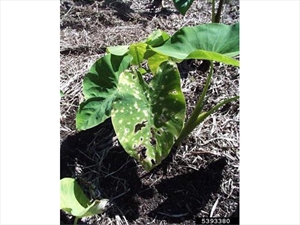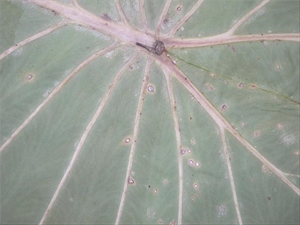Taro (Leptosphaerulina) leaf spot. CABI gives the preferred common name as soyabean leaf spot. In the USA, it causes alfalfa lepto leaf spot. Alfalfa is a forage legume.
Pacific Pests, Pathogens, Weeds & Pesticides - Online edition
Pacific Pests, Pathogens, Weeds & Pesticides
Taro (Leptosphaerulina) leaf spot (318)
Leptosphaerulina trifolii. Previously known as Sphaerulina trifolii and Leptosphaerulina briosiana.
Asia, Africa, North and South America, Europe, Oceania. It is recorded from Australia, American Samoa, Marshall Islands, New Zealand, Niue, Samoa, Solomon Islands, Tuvalu, and Vanuatu.
A wide range of hosts in several families. In the Pacific islands, it is recorded from taro and Alocasia, cassava, Chinese cabbage, several legumes (soybean, French bean, peanut, Centrosema), rice, tomato, yam and the weed, Oxalis.
A fungal disease associated with leaf spots or dead areas on a wide range of hosts, for instance, a leaf spot on pepper (capsicum), and a target spot on beans. On taro, it is associated with leaf spots and also corm rots. On alfalfa, tan leaf spots are surrounded by brown margins, giving an 'eyespot', sometimes with a yellow halo.
Spread in rain and wind, and also said to be seedborne.
A minor disease of little economic impact on most crops. However, lepto leaf spot on alfalfa is reported to be severe in the colder states of the USA if plants are cut and left unharvested. In this situation, the fungus builds up on the leaves and stems, and spores spread to healthy plants.
Look for the white spots on older taro leaves, sometimes joining together, and falling out.
In the Pacific islands, there is no treatment suggested for this disease as it causes little or no economic impact. On legumes, e.g., alfalfa in the USA, lepto leaf spot is managed by early harvests, avoiding leaving cut plants in the field, crop rotation away from forage legumes for 2 years, and varietal tolerance.
AUTHORS Grahame Jackson & Eric McKenzie
Information from Carmichael A, et al. (2008) TaroPest: an illustrated guide to pests and diseases of taro in the South Pacific. ACIAR Monograph No. 132, 76 pp. (https://lrd.spc.int/about-lrd/lrd-project-partners/taropest). Photo 1 Fred Brooks, University of Hawaii at Manoa, Bugwood.org. Photos 2&3 (taken by Eric McKenzie), and used in this fact sheet, appeared previously in McKenzie E (2013) Leptosphaerulina trifolii: PaDIL - (http://www.padil.gov.au).
Produced with support from the Australian Centre for International Agricultural Research under project PC/2010/090: Strengthening integrated crop management research in the Pacific Islands in support of sustainable intensification of high-value crop production, implemented by the University of Queensland and the Secretariat of the Pacific Community.






